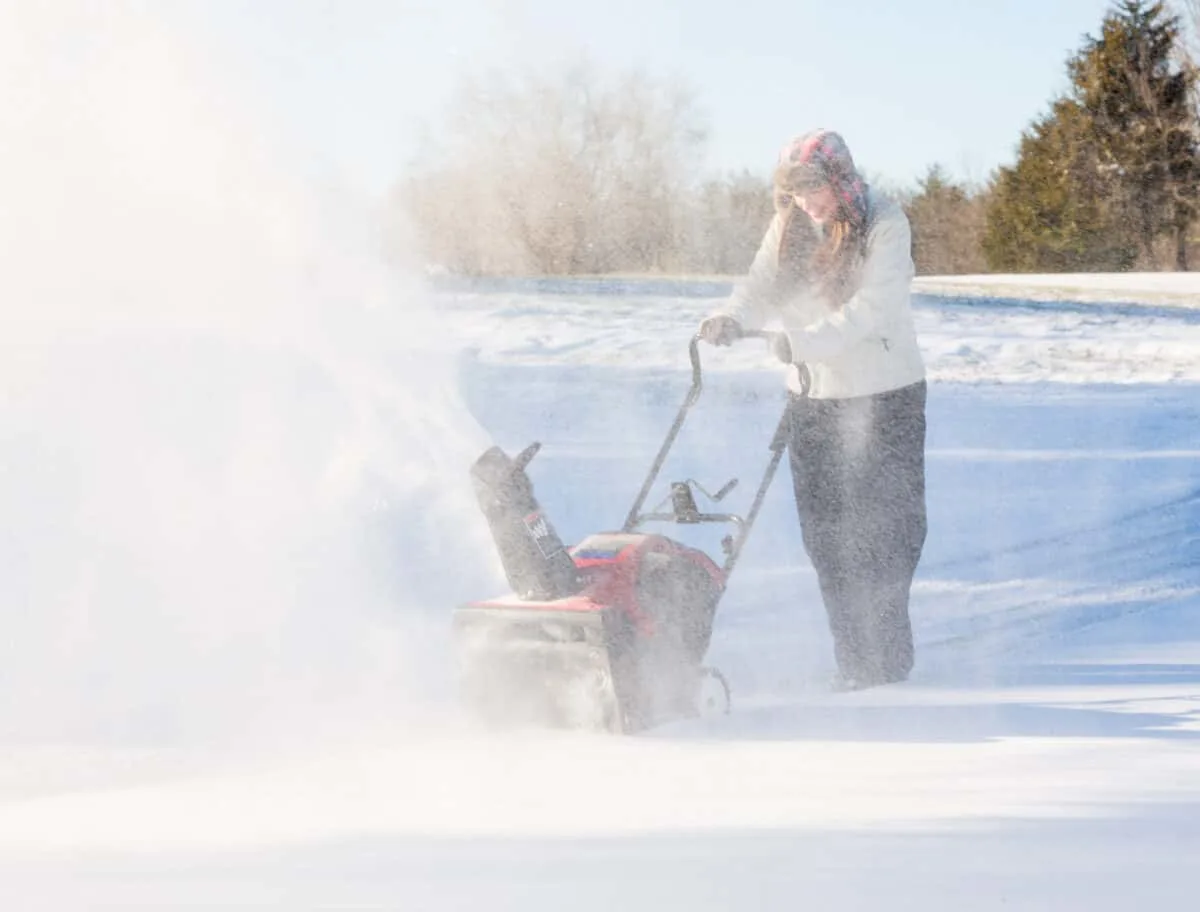I speak from (a lot of) experience when I say there is nothing worse than being out clearing your driveway when your snowblower clogs. It is so frustrating and time-consuming to fix the problem in snowy conditions.
However, I have also found it to be easily avoidable! You can prevent a snowblower from clogging by using one or many different techniques such as pushing the machine faster, clearing the path of objects or using a non-stick spray or lubricant.
Different techniques work differently depending on the machine you have and the conditions you are working in. I have personally tried all the methods below in various conditions.

Related Posts:
- Best Brands of Snowblowers
- Minimum Depth to Use a Snowblower
- How to Save Money Buying a Snowblower
- Are Snowblowers Worth the Money?
Why Do Snowblowers Clog?
To understand how to unclog your snowblower, you first want to understand what causes the machine to clog.
While it is possible for your snowblower to clog with any type of snow, I have found it is most common when the snow is either sticky or a combination of snow and ice. This then builds up around the auger or augers (depending on if you have a one-stage or two-stage snowblower) or at the top of the snow shoot and prevents the snow from being pushed out through the snowblower.
How To Prevent a Snowblower from Clogging
There are multiple different things you can do to try and prevent your snowblower from clogging. I have personally tried all these techniques and found some to work better than others. However, it really depends on the snowblower that you have, the conditions you are working in and the area that you are looking to clear of snow.
Non-Stick Spray
One way to prevent your snowblower from clogging is by applying a specially designed non-stick snow spray to the augers and shoot of the machine. The non-stick snow removal spray comes in an aerosol can making the application process is quick and easy. It is also very affordable and can be picked up from most DIY stores or online.
The spray works in a similar way to cooking oil in a pan and causes the metal interior of the machine to become slippery therefore preventing the attachment of snow.
I have had friends suggest using cooking oil or WD-40 instead of the non-stick spray as a less expensive solution. I found this did not work as well as the specially designed stuff because it needed reapplying every 15 minutes or so.
Meanwhile, the specially designed non-stick snow spray I applied lasted a couple of snowstorms over a couple of weeks.
Related Post: Where to Donate a Snowblower
Propel The Machine Faster
If you often find that you get wet, heavy snow or ice then you may want to consider getting a self-propelled snowblower. This is because slow propulsion of the machine is designed to encourage the accumulation of snow in the snowblower shoot. The faster the snowblower moves the faster the snow is going to be pushed through the machine.
However, I have also found that trying to remove less snow in one go by positioning the machine so that the augers on the front only cover half the snow instead of a full path of snow is going to allow the machine to work better in heavy snowfall.
This allows the force of the entire machine to only work on clearing half the snow propelling the snow through the machine and out of the shoot faster and often further.
Related Post: Difference Between Snowblowers vs. Snow Throwers
Ensure The Area Is Free of Obstructions
You would be surprised (or maybe horrified) as to how many times I have accidentally clogged my machine by running over the newspaper. In fact, it is becoming somewhat of a standing joke in our house.
Snowblowers are designed for snow, so if the machine begins to chew up anything else in its path do not be surprised if it stops working.
To prevent this, I have found it is best to always clear the area you plan to use the snowblower on prior to the snowfall (when the snow is forecast) and to only use the correct machine under the correct circumstances.
For instance, do not use a single stage snowblower on a gravel driveway.
If you do accidentally find that you have clogged your machine, please follow the safety instructions. Plenty of machines come with a cleaning tool which will allow you to easily remove most objects.
IMPORTANT: Removing foreign objects from a clogged snowblower is the number one cause of accidents from snowblowers in the U.S.
Taking this small amount of time to prep the area before using the snowblower is likely to significantly minimize the likelihood of your machine becoming clogged or damaged as a result.
Related Post: Everything to Know About Universal Keys for Snowblowers
Allow The Machine to Warm Up
To get the best results from your snowblower and to avoid damaging the machine I always suggest allowing five minutes after starting for the machine to warm up.
After these five minutes, I personally start with areas of light snowfall where possible before moving to areas with a heavy snowfall last.
This precaution will give your engine enough time to warm up and give it momentum to handle regions with the most compacted snow.
For a more enjoyable experience when out in the cold, consider upgrading to heated grips for a snowblower.
Preventing a snowblower from clogging is just one of the maintenance tasks to do when using a snowblower this winter. Here are more ways to keep your snow removal machine working properly:
- How to Clean a Snowblower Carburetor (Step-by-Step Guide)
- How to Dispose of Snowblower Oil
- Ways to Fix a Flat Tire on a Snowblower

